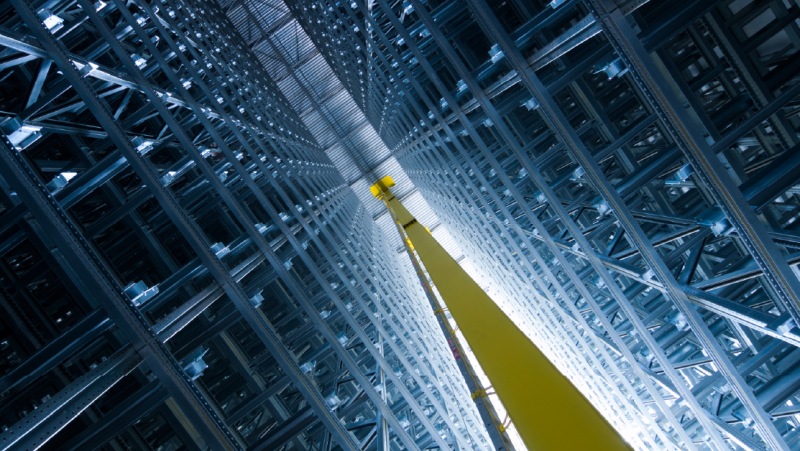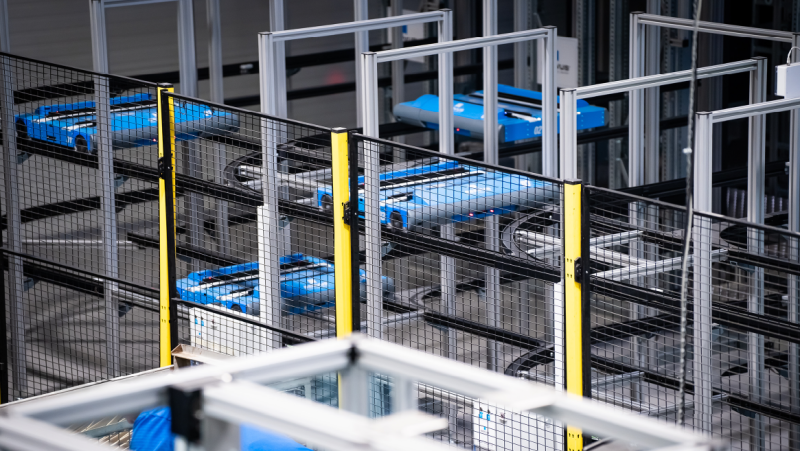How to Approach Logistics Automation
- Automation
- Article
Automation. It’s so tied to industrial manufacturing that about everyone thinks of robots when they think of assembly lines. But what do you think of when you hear the phrase “internal logistics automation”? Self-driving forklifts? Conveyor belts? Warehousing and logistics was a back-burner field until recently, but now it’s time to change that. After all, inefficient intralogistics processes generate considerable financial losses. Thanks to the latest technologies, we can free workers’ hands and take productivity to a new level. But how does one approach automation? What are its possibilities? What can it lead to? We have some answers for you.
Warehouse automation – the reasons and benefits
Automation is above all here to serve people – whom it replaces for demanding and/or repetitive tasks. In internal logistics, wherein materials enter the company at the warehouse and exit it e.g. at the assembly line, the goal is to transport goods, materials, or works in progress to the right place, on time, and at the required quality, with minimal human intervention. This fact is the foundation of the most common motivations and benefits for automation of intralogistics processes.
| Motivation | Benefit |
|---|---|
| A lack of qualified personnel | Optimisation of labour and of personnel routes; transfers to activities with higher added value |
| Error rates | Error elimination |
| Inefficiency and slowness in internal logistics | Standardisation of processes; transport-time savings |
| Limited warehouse capacities | Maximisation of space utilisation |
| Employee safety | Lowering/elimination of accident risks |
All these benefits are hard facts that aren’t hard to state in figures. Yet there are important feelings behind automation as well – ensuring that your competitors and customers feel the courage and financial stability that have enabled your company to embark on a change as far-reaching as logistics automation is. Only true industry leaders have the vision and boldness to dive into a project that addresses not only short-term problems but above all the long-term ones – a solution that will still be of service a decade from now. But the first step must be taken today. For the successful realisation, besides capital, a great deal of patience and élan must be invested as well, along with the right partners for the project.
Automation path no. 1: introducing technologies gradually
There are two main ways to approach automation: a gradual path of introducing individual technologies one by one, or a big bang. Most companies go for the first option, but despite this, fully automated warehouses that work without human intervention are becoming more and more common. We’ll be covering these later. What are the basic technologies involved in the gradual automation of internal logistics?

Warehouse Management System (WMS)
A WMS actually amounts to the automation of a warehouse’s data entry. This system replaces pen and paper, which remain very common helpers in warehouses even in the 21st century. Even just introducing a WMS saves on the time needed to compose work queues, do stocktaking and track down goods. Picking without a warehouse IT system is highly dependent on operators’ knowledge of where goods are stored; with a WMS it becomes possible to show a specific picking position in the warehouse and to optimise the work queue to prevent forcing an operator to walk across the warehouse. Thus, together with the use of barcodes, a warehouse system is a clear first choice of all logistics experts. And the result? Faster and more efficient warehouse operations, fewer kilometres walked, compliance with the rules for FIFO and other methods, traceability for materials used and more. And all this happens automatically, without any hand-copying or mistakes – and also quickly and simply.
The “goods-to-person” concept
As the name implies, this is a method wherein each handling unit comes to the operator rather than vice-versa. Some sources state that operators’ movements around a warehouse can take up to 50% of their picking time. A combination of conveyors and vertical storage systems makes it possible to move needed materials straight to the required location. That represents a significant saving – faster put-away and retrieval and fewer warehouse operators needed, enabling you to shift operators to work with higher added value. And since we all know it’s essential to retain capable and talented people, automation is a win-win situation on all sides.
Smart handling equipment
From enhancing the current fleet with a terminal at which operators can see the work queue and items’ storage locations, all the way to semi- and fully-automated vehicles, handling equipment is an integral part of automating logistics processes. In a future article, we’ll take a more detailed look at what such a fleet’s possibilities are and what it means to acquire and integrate it.
All three of these logistics automation elements can function separately, and they often do. Smart handling equipment such as semi- and/or fully-automated VNA (Very Narrow Aisle) forklifts and sorting systems are usually integrated into the remaining processes at a basic level. Much greater synergy and efficiency, however, can be achieved by fully interconnecting and integrating the individual technologies, processes and people into a single functional whole. This brings us towards the second approach, warehouse automation.
Automation path no. 2: the big bang
When complete and comprehensive intralogistics process automation is required, a company needs to let go of their current state and individual improvements. The management of a manufacturing company that stands before an automation decision must consider what its internal logistics demands will be in ten years – or where it wishes its logistics to be at that time. And that above all demands a clear vision and the courage to introduce changes that people will often fear. With a project this enormous, prepare yourself for many questions, internal justification, and even initial rejections. An implementation team must be created and motivated as well, and its members must in turn defend the benefits of automation before management, their colleagues, and their subordinates. And of course, there is the financial aspect as well. Because automation is a project that affects every level of a company and must be approached accordingly. But how do you convince everyone and – perhaps – dispel doubts of your own as well? Two techniques are the best in our experience:
- Take a reference visit to a company where automation has already been introduced and where they can tell you about its upsides and downsides.
- Choose partners that have experience with similar projects and that “fit” into your internal team. After all, you will all be in close contact for several months.
Complete automation uses all technologies that gradual automation does, but it can also involve further ones:
A fully automated warehouse
An Automated Storage and Retrieval System (AS/RS) works fully autonomously, and in fact, for safety reasons, humans are not even allowed to enter its storage zone. Even though it is demanding to deploy, we are seeing ever-broader use of the AS/RS, not only in automotive – but in other fields as well.
Autonomous mobile robots, trains and more
The above-mentioned technologies may be joined by Autonomous Mobile Robots (AMRs), trains, Autonomous Intelligent Vehicles (AIVs) and other machines that pick up materials or components at transfer points and take them where needed, replacing people in this role. The pioneers here are certain e-commerce companies, at which robots serve entire halls, from put-away to shipping. Even so, these are exceptions, and we will still have to wait a bit before this becomes a standard.
The systems integrator – the magician who brings it all to life
The systems integrator (the control system provider) plays an important role in logistics automation. Not only do they integrate the technologies, but they also set up the needed processes and ensure that all technologies communicate with each other, the data gets recorded where it should, and pallets never pile up or collide at crossroads.
When a fully automated warehouse is in use, its warehouse control system must encompass not only ordinary operations such as picking and put-away at specific positions, but also non-standard (error) situations previously handled by humans. All the warehouse’s logic must be set up and will then determine where pallets will be put away. It will have a “back door” for use during outages of any of the key technologies (for example the automated stackers), and it will ensure such things as correct storage into double-deep positions, the delivery of specific materials and components to the correct places for handover to manufacturing, and physical checks of handling units. In short, the systems integrator is the magician who breathes life into tons of steel in the form of racks, forklifts, stackers, conveyors and other technologies and is thus a key partner for the success of the entire automation project. So choose them carefully.
Automation does have its pitfalls
Besides the implementation process, automation has other pitfalls and stumbling blocks that must also be factored in. These are very human factors.
Vision and courage
Especially for small and medium enterprises, a warehouse automation project can be quite a bite to chew. You thus must be bold when heading into this type of project, and above all, you must choose partners of the sort that have automation experience and who are capable of mirroring your company’s vision for the future of its logistics into the proposed solution.
Standardisation and a partial loss of flexibility
Automation brings one major advantage – it forces standardisation. As mentioned above, the system must be able to handle every potential situation and a company will often discard unnecessary processes during its automation projects. This brings with it a partial loss of flexibility. Implementing a new process or adapting a workflow no longer means an agreement among staff members; now a system adjustment is needed. However, the pressure for flexibility is also shifted towards the flexibility of the control system, which must be easy to tailor to the given company’s specific processes. Implementing an automation project is no easy task when there is no way to adjust the decision and control algorithm. Thus you should demand a system that can be customised both during deployment and throughout its lifetime.
People
It remains the case that people – both at the customer and at the supplier – are the most important factor in digitalisation and automation. An experienced system integrator that can lead you in the right direction is a must. This partner should also have an internal team at the customer side that will work with the system and its technologies. Because for years now, work in internal logistics has required technical knowledge. The constant advance of automation is leading to a need for people who can manage, maintain and elevate automation and its technologies and processes. The only people who can do that are your internal staff who understand your processes and logistics, and who thus will be not only key users during the automation project, but also designers of new processes and initiators in the deployment of technologies that will help their company to take and keep the lead.
Share article
Top stories from logistics, production and IT.
Subscribe to Aimtec Insights
By registering, you agree to the processing of your personal data by Aimtec as described in the Privacy policy.
Get top stories and articles
from Logistics, Production and IT.
Subscribe to Aimtec Insights
By registering, you agree to the processing of your personal data by Aimtec as described in the Privacy policy.








